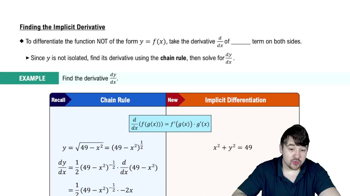Table of contents
- 0. Functions7h 52m
- Introduction to Functions16m
- Piecewise Functions10m
- Properties of Functions9m
- Common Functions1h 8m
- Transformations5m
- Combining Functions27m
- Exponent rules32m
- Exponential Functions28m
- Logarithmic Functions24m
- Properties of Logarithms34m
- Exponential & Logarithmic Equations35m
- Introduction to Trigonometric Functions38m
- Graphs of Trigonometric Functions44m
- Trigonometric Identities47m
- Inverse Trigonometric Functions48m
- 1. Limits and Continuity2h 2m
- 2. Intro to Derivatives1h 33m
- 3. Techniques of Differentiation3h 18m
- 4. Applications of Derivatives2h 38m
- 5. Graphical Applications of Derivatives6h 2m
- 6. Derivatives of Inverse, Exponential, & Logarithmic Functions2h 37m
- 7. Antiderivatives & Indefinite Integrals1h 26m
- 8. Definite Integrals4h 44m
- 9. Graphical Applications of Integrals2h 27m
- 10. Physics Applications of Integrals 2h 22m
4. Applications of Derivatives
Implicit Differentiation
Problem 3.8.42b
Textbook Question
Surface area of a cone The lateral surface area of a cone of radius r and height h (the surface area excluding the base) is A = πr√r²+h².
b. Evaluate this derivative when r=30 and h=40.
 Verified step by step guidance
Verified step by step guidance1
First, identify the formula for the lateral surface area of a cone, which is given as A = πr√(r² + h²).
To find the derivative of A with respect to r, apply the chain rule. The expression inside the square root, r² + h², is a function of r, so differentiate it with respect to r.
The derivative of r² with respect to r is 2r, and since h is a constant, the derivative of h² with respect to r is 0. Therefore, the derivative of r² + h² with respect to r is 2r.
Now, differentiate the entire expression A = πr√(r² + h²) with respect to r. Use the product rule, which states that the derivative of a product u*v is u'v + uv'. Here, u = πr and v = √(r² + h²).
Evaluate the derivative at r = 30 and h = 40 by substituting these values into the derivative expression obtained in the previous step.
 Verified video answer for a similar problem:
Verified video answer for a similar problem:This video solution was recommended by our tutors as helpful for the problem above
Video duration:
1mPlay a video:
Was this helpful?
Key Concepts
Here are the essential concepts you must grasp in order to answer the question correctly.
Lateral Surface Area of a Cone
The lateral surface area of a cone is the area of the cone's curved surface, excluding the base. It is calculated using the formula A = πr√(r² + h²), where r is the radius and h is the height of the cone. This formula derives from the geometry of the cone and involves the Pythagorean theorem to account for the slant height.
Recommended video:

Example 1: Minimizing Surface Area
Derivative
A derivative represents the rate of change of a function with respect to a variable. In this context, it helps determine how the lateral surface area A changes as the radius r varies, while keeping the height h constant. The derivative is calculated using differentiation rules, which provide insights into the behavior of the function at specific points.
Recommended video:

Derivatives
Evaluation of Derivatives
Evaluating a derivative involves substituting specific values into the derivative function to find the instantaneous rate of change at those points. In this case, after finding the derivative of the lateral surface area with respect to r, we will substitute r = 30 and h = 40 to compute the exact rate of change of the surface area at that radius.
Recommended video:

Evaluate Logarithms

 5:14m
5:14mWatch next
Master Finding The Implicit Derivative with a bite sized video explanation from Nick
Start learningRelated Videos
Related Practice



